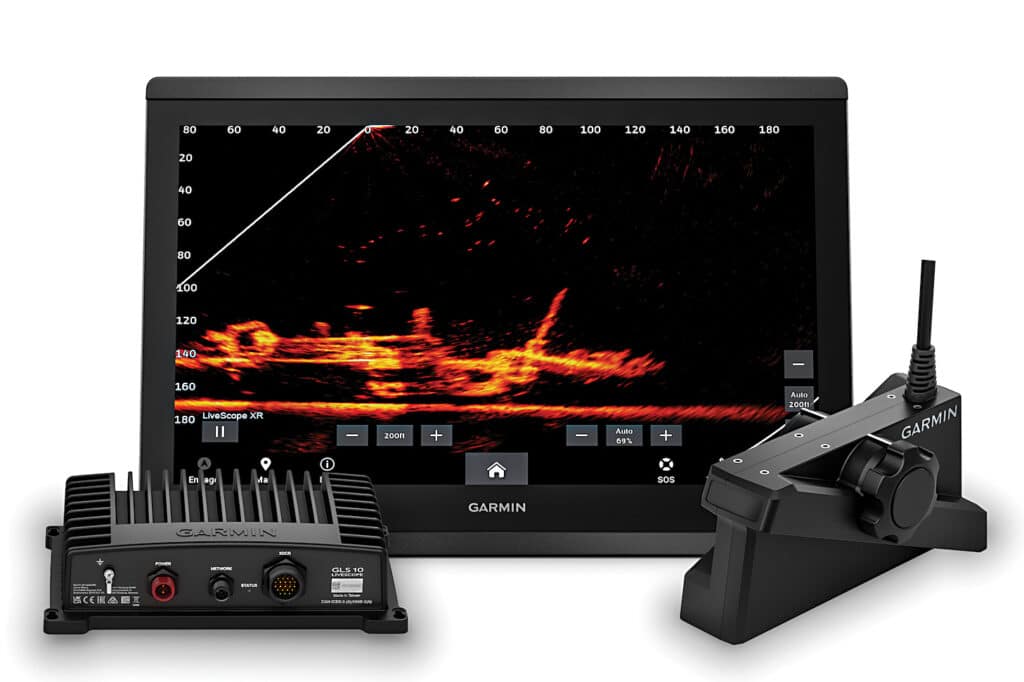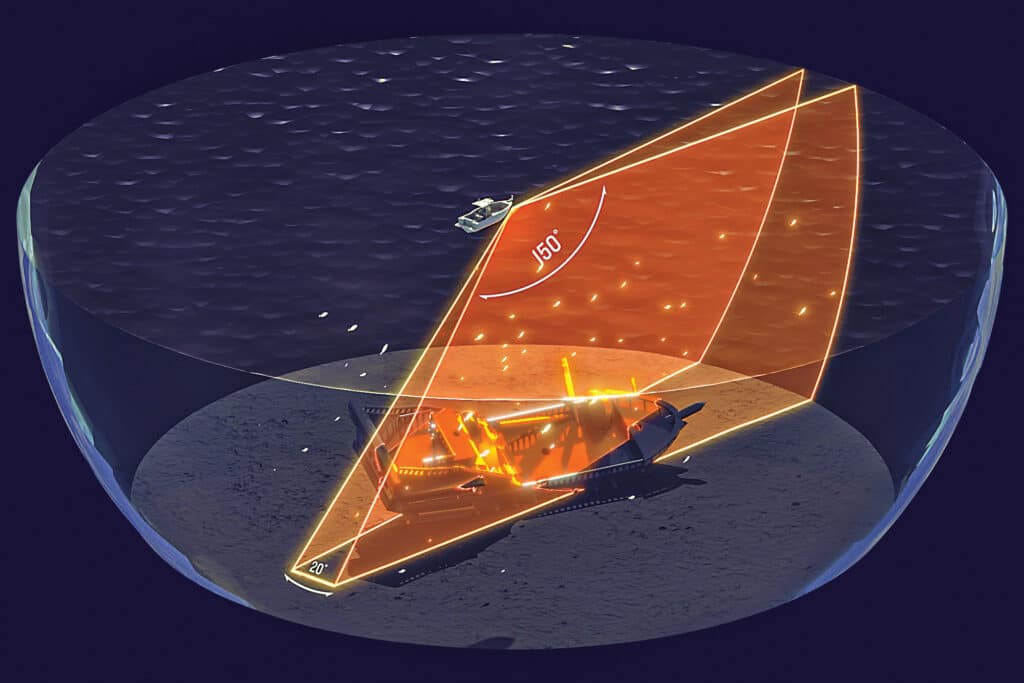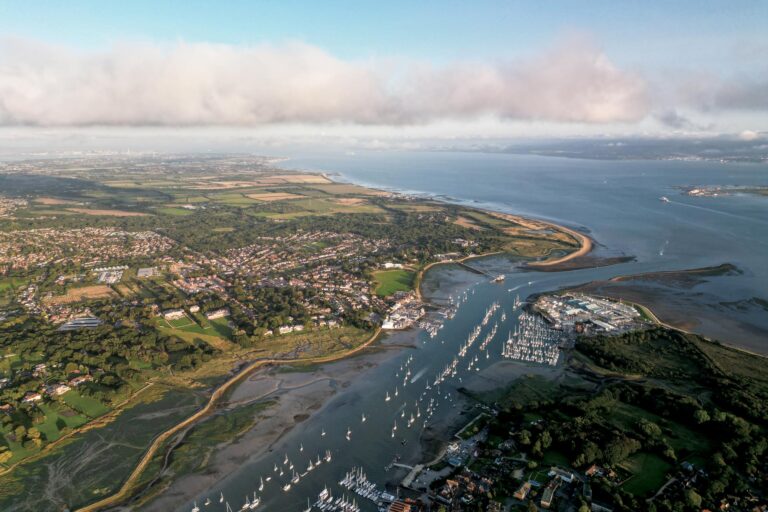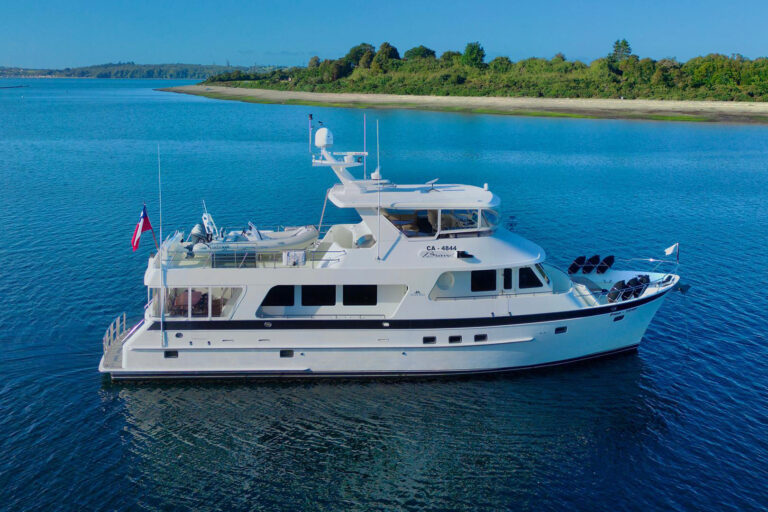
The first time a sonar really impressed me occurred at the 2015 Miami International Boat Show, when Dave Dunn, Garmin’s senior director of marine sales, and I escaped the mayhem for an on-the-water demo of Garmin’s Panoptix PS31 forward-looking sonar.
Dunn cast a line, and in close to real time, the lure appeared onscreen. The drama climaxed when a tarpon swam by, but it chose not to consummate the affair.
The fish’s mouth stayed shut, but mine swung ajar: Unlike previous-generation single- or dual-frequency transducers, which produce standard two-dimensional views, the Panoptix PS31 produced three-dimensional imagery. Better still, the system gave us the choice of multiple viewing angles.
Since then, Garmin’s engineers have been busy making the system even better.
Anglers first started embracing fish finders in 1957, following Darrell Lowrance’s invention of the Fish-Lo-K-Tor. Since then, fish finders have become far more powerful, including phased-array multibeam sonar that yields 3D imagery of everything—both stationary and swimming—below the keel.
Garmin replaced its Panoptix sonars in 2018 with the company’s next-generation LiveScope. While multibeam sonars with higher transmit power and greater screen resolution are available, Garmin’s latest LiveScope Plus and LiveScope XR are the only systems that allow users to change their transducer’s angle of attack to yield three different live viewing angles: forward mode, down mode and perspective mode. Each delivers unique situational and fish-striking awareness.

Early 2022 saw the addition of LiveScope Plus ($1,700), and by midyear, there was LiveScope XR ($3,000). While LiveScope Plus has improved onscreen target separation, LiveScope XR offers enhanced range. All three systems use the same GLS 10 sonar black-box module, which transmits at 500 watts, but they use different transducers. The result is that LiveScope and LiveScope Plus have ranges of 200 feet (down and forward) in both freshwater and saltwater, while LiveScope XR yields a maximum range (down and forward) of 500 feet in fresh water and 350 feet in seawater.
While the systems are similar—users can switch from LiveScope Plus to LiveScope XR, or vice versa, by swapping transducers—LiveScope XR is the premium product. Its packing list is simple: one GLS 10 black box, one LiveScope XR LVS62 transducer, a perspective mount, a barrel mount for a trolling motor, a shaft mount, power and data cables, a network-adapter cable and product documentation.
While all bits and pieces are important, LiveScope XR’s LVS62 transducer is the star. It operates on a frequency of 265 to 550 kHz and can separate targets that are spaced by at least 22 inches at a range of up to 100 feet. Dunn says Garmin accomplished this target separation by using a sonar array that’s 2.5 inches larger than the first two LiveScope systems and arranged in an X-shaped pattern.
The LVS62 mounts to a trolling motor or a pole mount, and users adjust from forward, down and perspective modes by physically changing the transducer’s angle of attack. Anglers just click the LVS62 from one pre-configured position to the next using the mounts.
While Garmin sells pole mounts and trolling motors, readers are encouraged to build DIY designs.
As with all Garmin’s high-end transducers, the LVS62 was designed in Olathe, Kansas, and is built at Garmin’s Taiwan manufacturing plant.
Once installed, LiveScope XR yields a huge amount of below-keel information that’s displayed on a Garmin-built fish finder or multifunction display in a user’s choice of seven color palettes.
“It’s an open-water product,” Dunn says. “Some anglers are less concerned with resolution and more about range.” Given that LiveScope XR’s multibeam sonar can peer downward and outward to 350 feet (or 500 feet in freshwater), this equates to vast water-column imagery.
Unlike typical fish finders, LiveScope XR works when the boat is stationary. “With a 50/200 kHz transducer or Chirp fish finder, if the boat’s not moving, you won’t get a proper read.”
As each of the three live-view perspectives’ monikers imply, forward mode depicts what’s in front of the bow, down mode shows everything under both sides of the keel, and perspective view delivers a forward-looking, cone-like view of what’s happening across 150 degrees of underwater azimuth. The data yielded by each of these views and, more impressively, across all three creates what Dunn terms a “game changer” for anglers. “You can see where the fish are in that moment,” he says. “You can put the bait on their nose if you want to.”
Data-hungry anglers can get a higher level of split-screen awareness by installing dual GLS 10 black boxes and transducers while simultaneously displaying two sonar perspectives. (Tip: One transducer can be LiveScope XR’s LVS62, while the other can be LiveScope Plus’ LVS34.)
LiveScope XR, Dunn says, is designed for any vessel with a trolling motor. Given that the system is an open-water product, Dunn suggests that this setup is a great fit for center consoles or coastal boats, but he is quick to add that many search-and-rescue teams have gravitated toward LiveScope XR.
“It’s designed for anglers, but search and rescue has been one of our biggest, nontraditional customers,” he says.
Most important, Dunn says, is that LiveScope XR is designed for people who want to find fish and aren’t concerned with locating every tree stump or coral head. “They’re not looking for structure; they just want to know if there are fish,” he says. “Other times, they’re looking for bait.”
So, if you’re interested in a cost-effective way to find fish while seeing a whole lot more of the water column and the seafloor, LiveScope XR could be your ticket.
While the odds are good that your jaw will lower when you see the real-time underwater imagery, getting fish to consummate their end of the bargain remains part of the art of the reel.
Flexible Fish finder
For boaters who enjoy hard-water fishing, Garmin has the LiveScope Plus Ice Fishing Bundle LI. The system ($3,249) delivers 35 percent better resolution than Garmin’s previous iteration, and it provides 200 feet of range in all directions. The plotter and LiveScope Plus transducer also work for soft-water fishing.









